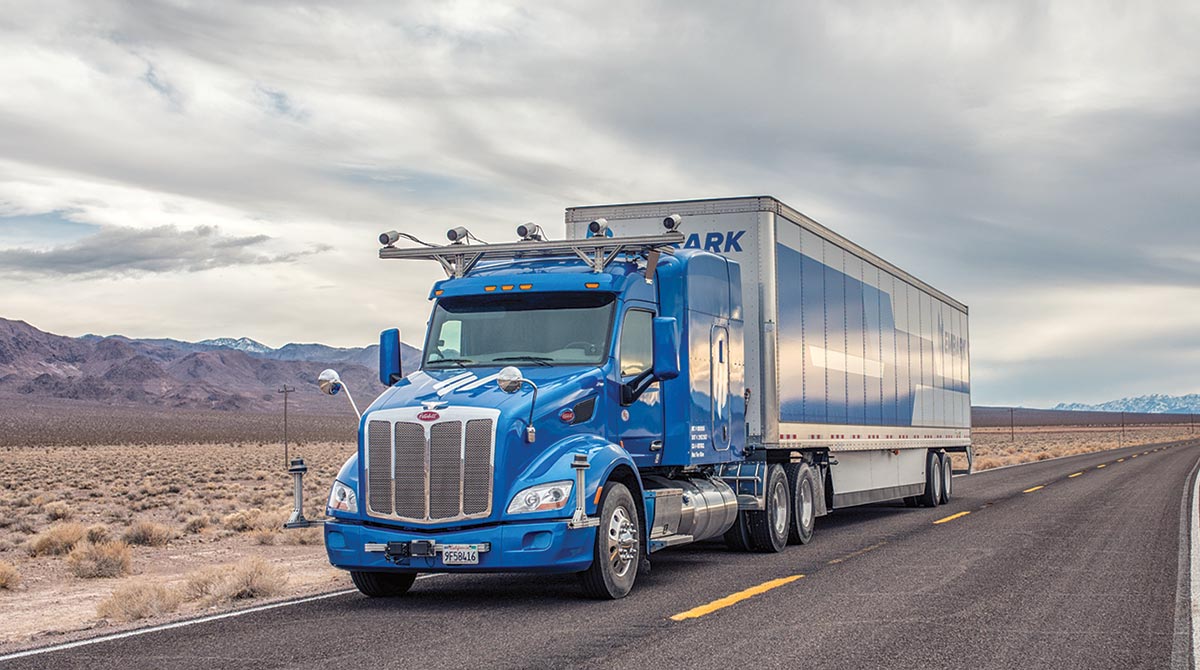Managing Editor, Features and Multimedia
TMC Explores Deployment of Automated Trucks

ATLANTA — Industry experts explored a variety of approaches for developing and deploying autonomous trucks and examined the evolving regulatory framework for this technology here at the annual meeting of the Technology & Maintenance Council.
One pathway to the future of automated trucking is to build upon today’s active-safety technology to create advanced driver-assist systems that could serve as a “stepping stone” to autonomy, said Fred Andersky, who heads the controls business and government and industry affairs at Bendix Commercial Vehicle Systems, a major supplier of braking and safety systems.

Fred Andersky, Bendix Commercial Vehicle Systems (John Sommers II for Transport Topics)
However, he also acknowledged the development work of technology firms such as Uber, Waymo and tuSimple, which are looking beyond ADAS and hope to eventually deploy vehicles that no longer need drivers, at least in certain operating conditions.
“These are folks with capital, and with a focus on getting to that autonomous truck future,” Andersky said during a March 7 technical session.
Whichever pathway ultimately wins, “there’s no doubt that the automated future is coming,” he said.
In the meantime, the emerging regulatory framework for automated trucks must allow this technology to evolve, said Mike Cammisa, vice president of safety policy and connectivity at American Trucking Associations.
RELATED: Drivers remain essential amid autonomous technology, trucking execs tell Senate panel
“We want to make sure there’s flexibility available for innovation,” he said. “If we start locking in technology or concepts today, we may find down the road that it’s changed.”
ATA recognizes that there are regulatory roles for both the federal and state governments, “but we want to make sure that they’re not in conflict or duplicating one another,” he said. “We want one regulatory regime where you can certify your vehicle or your technology once” and be able to use it when crossing state lines.
Several speakers at the conference agreed that truck drivers will continue to play an essential role in the industry for the foreseeable future, even as automation continues to advance.
“We see drivers being in the cabs of these vehicles for a very long time,” Cammisa said.
Instead of displacing drivers, “automation can help supplement their skills and improve their productivity,” he said.
Bendix’s Andersky agreed that truck drivers “are going to be around for a long time,” but added that the industry should begin thinking about the longer-term transition to driverless vehicles.
RELATED: How autonomous trucks could lead to more driving jobs, not fewer
While automated trucks could yield significant gains in safety and productivity, there could also be challenges.
“If there’s one thing that really keeps me up at night, it’s cybersecurity,” Andersky said. “There is no system that cannot be hacked.”
Mark Savage, deputy chief for the Colorado State Patrol, recounted how law enforcement officers moved beyond their initial skepticism of self-driving technology to support the first freight delivery by autonomous truck.
“We understood that this technology … could save lives,” he said. “It’s one of the ways we can get to zero deaths on our highways.”
The state patrol worked with the state’s department of transportation to help coordinate the famous autonomous beer delivery conducted in 2016 by Otto, which has since been merged into Uber’s Advanced Technologies Group.
Earlier in the conference, a standing-room-only crowd packed into a meeting of the automated driving and platooning task force, part of TMC’s Future Truck Committee.
Speakers included representatives from Embark and tuSimple, a pair of technology startups that are developing Level 4 systems that would enable trucks to drive autonomously without any driver input within certain parameters.

Embark
Today, Embark’s self-driving trucks still have a backup driver behind the wheel during test runs and freight deliveries, but the company’s goal is to eventually remove the driver from longhaul trucks that operate only on highways.
“If you can get these trucks to operate outside of hours of service, you’re talking about moving something by truck, coast to coast, in two days instead of five or six days,” said Jonny Morris, head of public policy at Embark.
Peterbilt Motors Co. also is eyeing the potential for automation to influence driver hours-of-service limits, said Bill Kahn, principal engineer and manager of advanced concepts.
“We basically would like to get the point where the driver could actually take his 10-hour break in the sleeper of the truck, while the truck continues to move,” he said.
However, the panelists saw serious challenges for Level 3 automation, where the driver can stop monitoring the road while the vehicle is in autonomous mode, but still must be ready to respond to a request to intervene in a timely manner.
“You’re putting a lot more cost on the truck for very little benefit [with Level 3],” Kahn said. “If we can’t influence hours of service, we can’t make enough money to offset the cost of the equipment.”
Onboard sensor systems can’t see far enough ahead to detect potential issues soon enough to bring the driver back into the loop if he’s not already paying attention, said Chuck Price, vice president of product at tuSimple.
“You’re just throwing a driver into a very bad situation, so we don’t think Level 3 is actually practically possible and safe,” he said.





